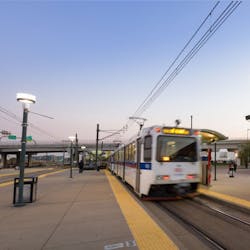Denver RTD Board approves policy to encourage development of affordable housing on RTD property
The Denver Regional Transportation District (RTD) Board of Directors approved the new equitable transit-oriented development (TOD) policy to help encourage development of affordable housing on district-owned properties adjacent to transit stations across the Denver metro region.
The focus on transit-oriented development isn’t new to RTD. The FasTracks Strategic Plan for TOD in 2008, updated in 2010, emphasized the need for this synergistic thinking about urban planning.
For RTD, the new policy gives staff needed flexibility when developers propose projects, for instance, on the surface parking lots adjacent to the station at Central Park or the similar swaths of asphalt at County Line. The new principles give RTD more wiggle room in talks with developers where no flexibility used to exist.
“RTD has a lot of land at transit stations, including many Park-n-Rides, and what this policy allows us to do is provide the parking that’s needed but also encourages developers to house the people who will most benefit from living at transit stations and who will actually use transit,” said Chessy Brady, RTD’s manager of TOD.
Using transit stations as a hub to spawn walkable communities reduces sprawl, improves safety around those stations and boosts livability of the urban environment, says Brady. But RTD is restricted from selling land below market value, no matter how worthy the cause.
Parking lots next to transit stations along FasTracks routes, of course, might be appealing targets for potential development. Prior to the passage of the new TOD policy, those developers would have been required to replace parking spots one-for-one. But adding the construction costs for a $10-million to $20-million parking garage, for instance, to the overall tab would make any developer’s accountant frown and put a major dent in the project’s viability.
The new TOD policy gives RTD staff the flexibility it needs to give developers a break by not requiring that parking spots be replaced on a one-to-one basis. In exchange for easing such requirements, however, the new policy allows RTD to set a non-binding goal that 35 percent of all housing developments on RTD property be priced as “affordable,” starting at 60 percent of median area incomes as a benchmark. Transit peers across the country also have such a policy, and RTD’s 35 percent goal is aligned with those of several California agencies in the Bay Area and Los Angeles.
RTD says the shortage of affordable housing in Denver is at crisis levels. Last summer, the National Community Reinvestment Coalition (NCRC) released a report that ranked Denver second on the list of “Most Intensely Gentrifying Cities 2013–2017,” just behind San Francisco and Oakland and before Boston. The city of Denver’s own figures show that the median income increased about eight percent between 2015 and 2018, while rent increased 13 percent and the cost of homes jumped by 17 percent. An estimated 96,000 households in Denver are spending more than one-third of total income on rent or mortgage.
While few experts agree how housing markets will recover post-pandemic, overall inventory in metro Denver remains low. So, the new TOD policy gives RTD an opportunity to do its part, at least, with the affordable housing issue. And research is clear, says Brady, that people who live in affordable housing do not need as much parking. More importantly, they rely more on public transit for their transportation needs than those living in market-rate houses, condos and apartments.
As the 2010 strategic plan noted, TOD creates efficiency and effectiveness for transit systems by increasing all ridership – especially off-peak. At the same, studies have shown that proximity to transit yields a premium for property values. Access to public transportation makes for a sweet amenity – like nearby dog parks or an Amazon Package Locker – to potential renters or buyers.
The new policy, says Brady, will spark more development “activation” around the transit stations that leads to housing, along with commercial spaces such as coffee shops and convenience stores and the kinds of shops and services that are naturally attracted to density.
The need for affordable housing is not going away. Neither is the need for public transit or the overall desire for urban lifestyles that give residents access to jobs, health care, groceries, restaurants and entertainment without hopping in a car and driving an hour for each need or want.
“Transit works in density,” Brady said. “It doesn’t work in sprawl.”
RTD’s new TOD approach, she adds, “signals our commitment” to working with cities and to turn these ideas into reality. And Brady acknowledged that every potential discussion around a proposed development will be pursued in close concert with all local jurisdictions and their individual planning needs and requirements.
